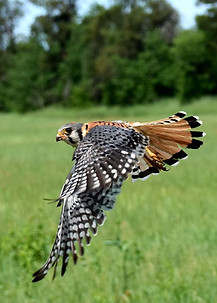ABOUT KESTRELS

_JPG.jpg)

The American Kestrel is the smallest and most numerous of all North American falcons. Its scientific name, Falco sparverius, means "falcon of the sparrows." Formerly known as the sparrow hawk, the American Kestrel is a beautiful, powerful species with a big personality.
Appearance
Adult kestrels are typically 8.5-12 inches long with a wingspan of nearly 2 feet, making it about the size of a bluejay. Adults have three vertical black facial stripes, as well as two black spots on the back of the head called ocelli. Ocelli may act as false eyes, tricking an enemy into thinking the falcon is looking right at them.
Males have blue-gray with rusty-orange bodies, and orange tailfeathers black tips. Females are rusty-orange throughout, with black or dark brown horizontal bars across the wings, body, and tailfeathers. Like all birds of prey, kestrel chicks are born precocial, meaning they are relatively mature, able to see, and feed themselves.
Female kestrel. Photo by Joe Janssen
Male kestrel. Photo by Stacy Taritas
Kestrel chick, a little fuzz-ball! Photo by CWKR
Habitat
Kestrels thrive in grassland habitats, where open prairies make finding prey easy and plentiful. Naturally, kestrels nest in tree cavities, particularly of dead tree snags. Because modern practice involves removing dead trees (usually for safety reasons), kestrels are almost completely reliant on man-made nest boxes to successfully hatch eggs, raise young, and fledge nestlings. Nest boxes are mounted on tall poles in grasslands.

Janet, Amber, and a volunteer retrieve kestrel chicks from a nest box to band and weigh them. Photo by Southern Wisconsin Bird Alliance
Diet
Kestrel adults and chicks generally feed on small mammals and insects. One exception to this appears to be when kestrel populations live in urban areas. New York City supports a healthy, breeding population of kestrels, where they live on busy city streets in building cornices, and feed primarily on small birds.
The rural kestrel typically hunts while perched on utility wires, fence posts, or from the tops of trees. They can also be seen hovering over open areas, searching for prey.
Eurasian Kestrels are able to locate voles (small mouse-like rodents) by being able to see their urine trails, which reflect ultraviolet light, visible to the kestrel's eyes. It is quite possible that the closely related and ecologically similar American Kestrel can do the same.

A small snake is a great snack for a kestrel chick. Photo by CWKR
Declines
Kestrels face two major challenges: their natural nesting habitat (cavities in tree snags) are becoming scarce, and their foraging habitat (grasslands) are also becoming less common and more fragmented. In fact, the kestrel population in our region declined 41% between 1966 and 2014, according to Breeding Bird Survey data, and that trend continues today.
But you can help! Learn more about our work, how to get involved, and ways to donate to keep kestrels present -- and even better, thriving -- in Wisconsin!
Learn more about American kestrels through the AllAboutBirds.org and the American Kestrel Partnership websites.


